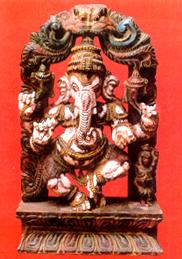|
 The advent of Agama Sastras made the practice of religion easy
for the Hindus. The elaborate ritualism of the vedas and the exacting
discipline of the yoga path were obviated by a simple process of idol
worship either at home or outside, in temples, Vedanta conceived God as
one without form but people started giving him forms according to their
mental developments and tendencies. Some gave him animal forms, some gave
him human forms and some gave him mixed forms and some represented him
in geometrical patterns. Ganesha comes under the mixed form. The advent of Agama Sastras made the practice of religion easy
for the Hindus. The elaborate ritualism of the vedas and the exacting
discipline of the yoga path were obviated by a simple process of idol
worship either at home or outside, in temples, Vedanta conceived God as
one without form but people started giving him forms according to their
mental developments and tendencies. Some gave him animal forms, some gave
him human forms and some gave him mixed forms and some represented him
in geometrical patterns. Ganesha comes under the mixed form.
These diverse ways of thinking and shaping of Gods arose more out of a
desire to satisfy a pristine and innocent urge in men than out of any
wanton profanity. But it is unfortunate that the credulity of these innocents
is being exploited by some others who are unscrupulous for purposes which
may very well be described as profane. God does not want idols or worship.
God is an immaculate law and knowledge of this law and obeying the law
would be more than sufficient to please Him. This is high thinking. But
people at lower levels caught in the grip of their own psychic aberrations
require some refuge and the several Gods, their idols and symbols all
constitute such a refuge set up for their psychic needs even as they put
up shelters variously improvised as refuge for their physical needs from
the vagaries of weather.
Ganesha has in this sense become a stupendous edifice for such people
to take shelter. This edifice was begun in prehistorical days and completed
after a lapse of several centuries. For people in the elementary stage
of thinking, Ganesha is a refuge. But for people with higher knowledge
he is a picture writing of philosophy and mysticism as could be made out
by the following prayer addressed to him:
"Eka Dantam maha kayam
thapta kanchana sannibham
Lambodaram Visalaksham
Vandeham Gananayakam." |